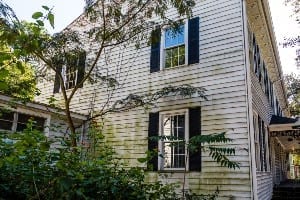Remodeling an old home is a rewarding and challenging process. We can help you decide what to do with the space, find contractors, and make sure you have everything you need to be comfortable in your new home.
Buying a house is an exciting milestone. Making it your own, however, is a different story. Whether you’re doing a whole-houses renovation or you’re simply thinking of redecorating, there’s a lot more to home remodeling than you might think.
Whether you’re doing minor repairs or major renovations, the process of home remodeling requires a significant amount of time and effort from all parties involved—especially if you’re working with an older property. At any time during the remodel, you can expect to encounter various obstacles that may have a huge impact on the outcome of your project.
To help you prepare for potential home remodeling hiccups, we’ve listed some of the more common ones below.
Contents
1. Foundation Issues.
Before you can transform an old home into a luxurious property, you need to make sure the foundation is solid. Problems in the home’s foundation can not only pose a serious health risk, but they can also discourage future sales. Properties built before 1940 often didn’t have sufficient water runoff grading, which greatly contributed to mold growth in basements.
Before you start your remodel, look for signs of foundation problems such as cracks in interior walls and floors, nails that come out of the drywall, and windows or doors that are stuck/won’t open.
2. Outdated Electrical and Plumbing Systems.
 Before the 1960s, it was common to use galvanized pipes for indoor plumbing. The problem with such pipes is that they clog easily and are highly prone to corrosion. If your home remodeling project involves plumbing, have your existing pipes analyzed. If they are, indeed, galvanized, consider replacing them with safe, more modern options—like copper or PVC.
Before the 1960s, it was common to use galvanized pipes for indoor plumbing. The problem with such pipes is that they clog easily and are highly prone to corrosion. If your home remodeling project involves plumbing, have your existing pipes analyzed. If they are, indeed, galvanized, consider replacing them with safe, more modern options—like copper or PVC.
Older electrical systems also present potential health risks, as the laws that mandated electrical wiring and cabling back then are vastly different than the ones currently in place. For older properties, we highly recommended getting your wiring professional examined and, if needed, replaced.
3. Properties Not Up to Code.
Residential code should always be followed in all kinds of construction to avoid potential legal issues. If your property is older, you need to make sure that it’s still compliant with current residential codes. Work with your contractor to ensure that your whole remodeling project is legal and code-compliant. This will protect both the people living in your home and your valued investment in your property.
Related Content: 4 IMPORTANT LEGAL ASPECTS OF A REMODEL EVERY HOMEOWNER SHOULD KNOW
4. Mold and Dry Rot.
 Another common problem with older homes is mold, which is most likely to show up in areas where water can easily seep through. Common culprits? Leaky pipes, basement walls, and slanted roofing. Before starting your home remodeling project, have a professional examine these areas in your home just to make sure the chance of rot forming is minimal.
Another common problem with older homes is mold, which is most likely to show up in areas where water can easily seep through. Common culprits? Leaky pipes, basement walls, and slanted roofing. Before starting your home remodeling project, have a professional examine these areas in your home just to make sure the chance of rot forming is minimal.
That’s not all. The moisture that contributes to mold formation can also lead to dry rot. It attracts a type of fungus that feeds on wood, eventually weakening it. Over time, the affected material becomes brittle and cracked. Not long after that, it can completely break down.
Dry rot typically affects homes that have not been treated for rot damage prevention. If you haven’t had your home looked at, pre-remodel is as good a time as any to get a thorough checkup.
Related Content: 3 THINGS WHICH CAN DELAY YOUR HOME REMODELING PROJECT
5. Presence of Lead Paint.
Lead paint is a harmful material that is usually found in homes built before 1978—the year when the federal government finally banned its use.
Before your remodel, have your property examined for any trace of lead-based paint—especially if you’re planning some major repairs, repainting, or renovations. Lead paint isn’t dangerous as long as it remains undisturbed. The moment it breaks, chips, peels, or scrapes, then it becomes a serious health hazard. So before you do any large or full-scale remodeling projects, have a professional verify that your home is free of lead.
Getting Assistance from Professionals for Remodeling An Old Home
Unlike newer properties, older homes have a unique charm—making them a popular choice for many buyers and homeowners who love home remodeling and redesigning. If you own an old home, be aware of the issues mentioned above. This sort of knowledge can help you and your family stay safe and protected as you create your dream home.

Recent Comments